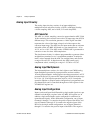
Chapter 2 Configuration and Installation
AT-MIO-16X User Manual 2-44
©
National Instruments Corporation
The CB-50 is useful for prototyping an application or in situations
where AT-MIO-16X interconnections are frequently changed. When
you develop a final field wiring scheme, however, you may want to
develop your own cable. This section contains information and
guidelines for designing custom cables.
In making your own cabling, you may decide to shield your cables.
The following guidelines may help:
• For the analog input signals, shielded twisted-pair wires for each
analog input pair yield the best results, assuming that differential
inputs are used. Tie the shield for each signal pair to the ground
reference at the source.
• The analog lines, pins 1 through 23, should be routed separately
from the digital lines, pins 24 through 50.
• When using a cable shield, use separate shields for the analog and
digital halves of the cable. Failure to do so results in noise from
switching digital signals coupling into the analog signals.
Cabling Considerations for the AT-MIO-16X with 68-Pin
I/O Connector
National Instruments has a 68-pin mating connector and shell kit you
can use with the AT-MIO-16X board. In making your own cabling, you
may decide to shield your cables. The following guidelines may help:
• For the analog input signals, shielded twisted-pair wires for each
analog input pair yield the best results, assuming that differential
inputs are used. Tie the shield for each signal pair to the ground
reference at the source.
• If you use a non-shielded cable such as a ribbon cable:
– Route the analog lines separately from the digital lines.
– When using a cable shiled, use separate shields for the analog
and digital halves of the cable. Failure to do so results in noise
from switching digital signals coupling into the analog signals.


















